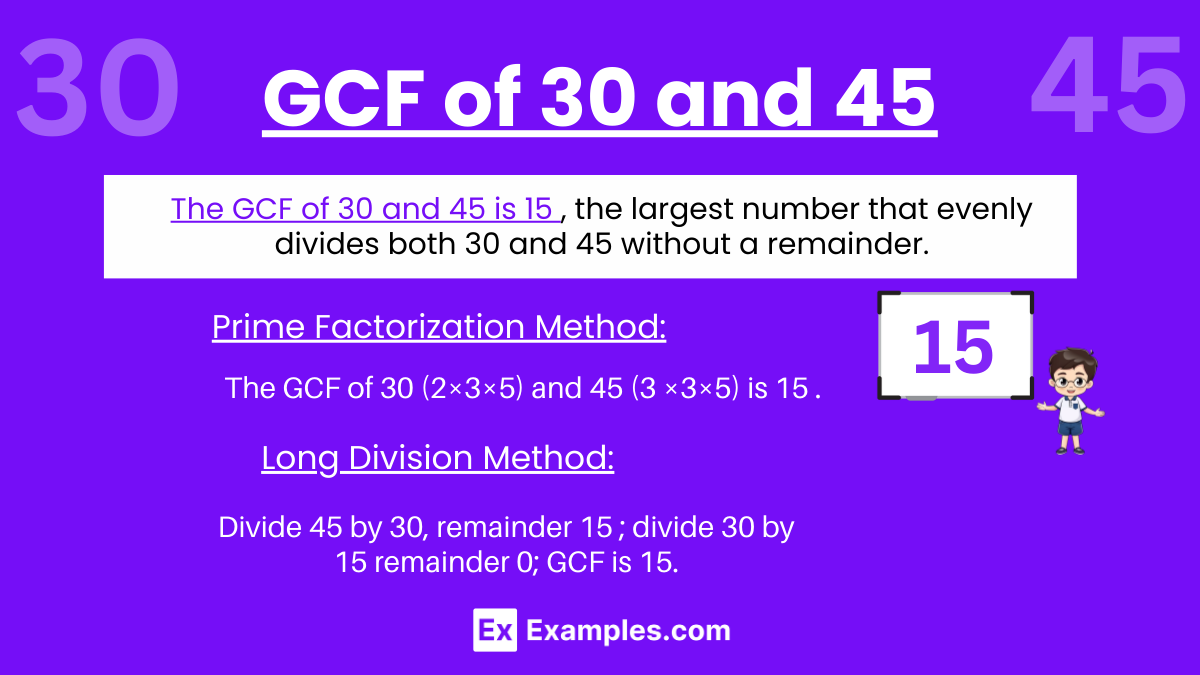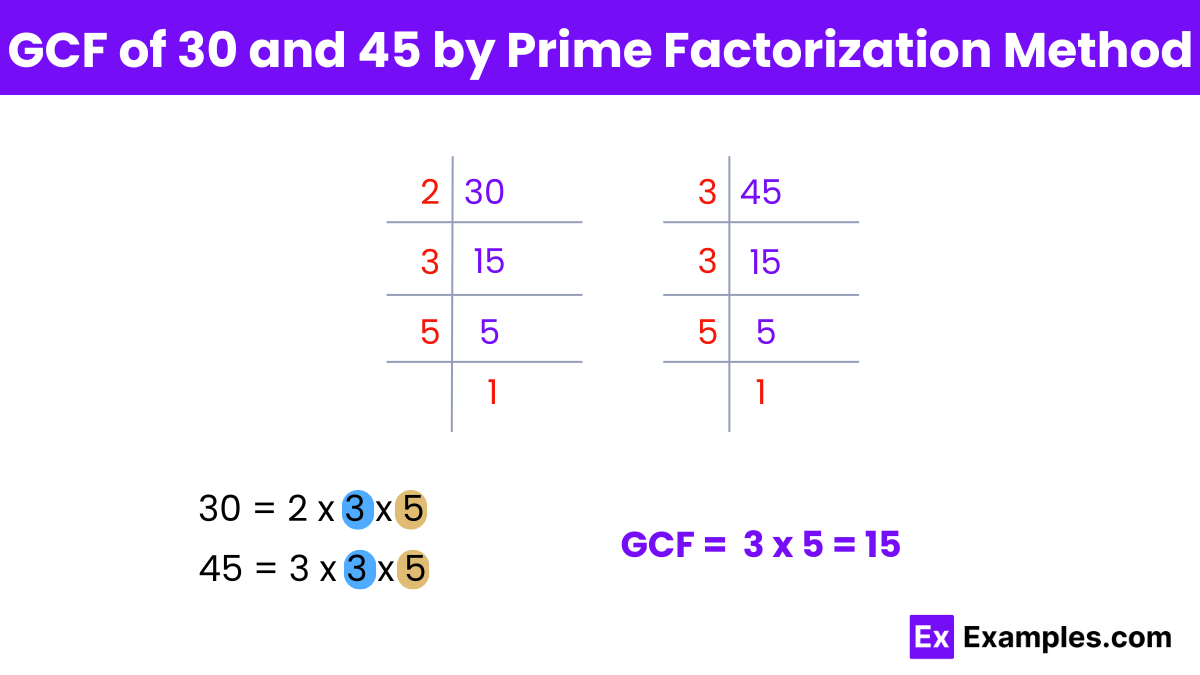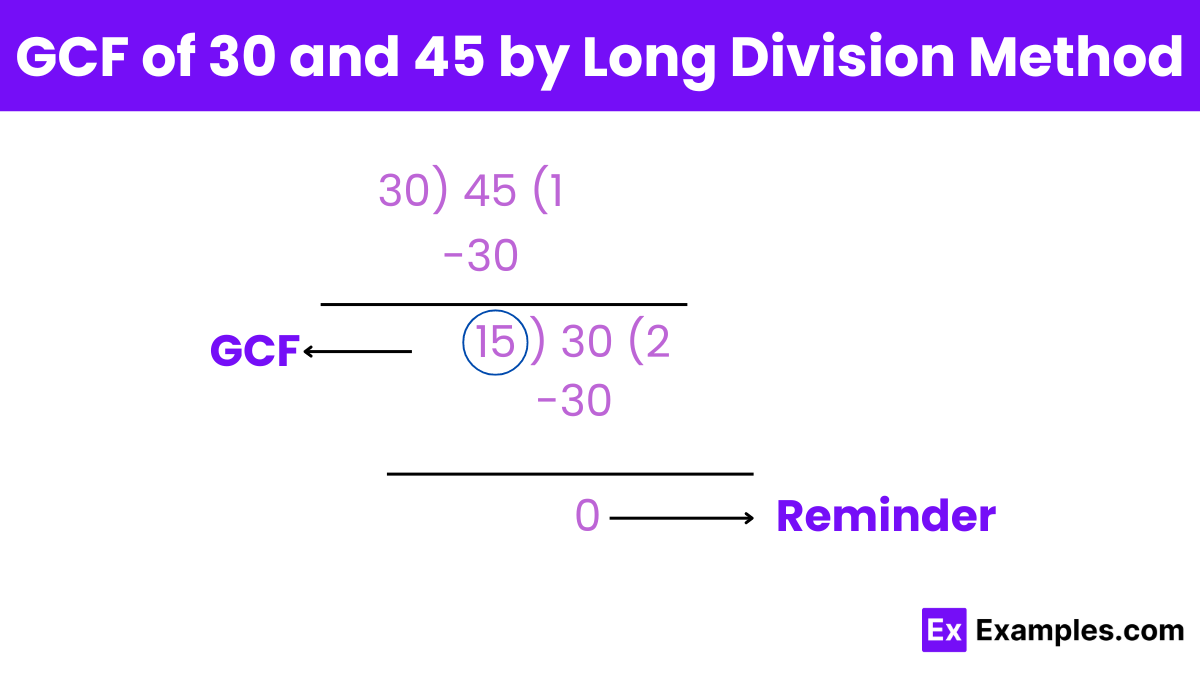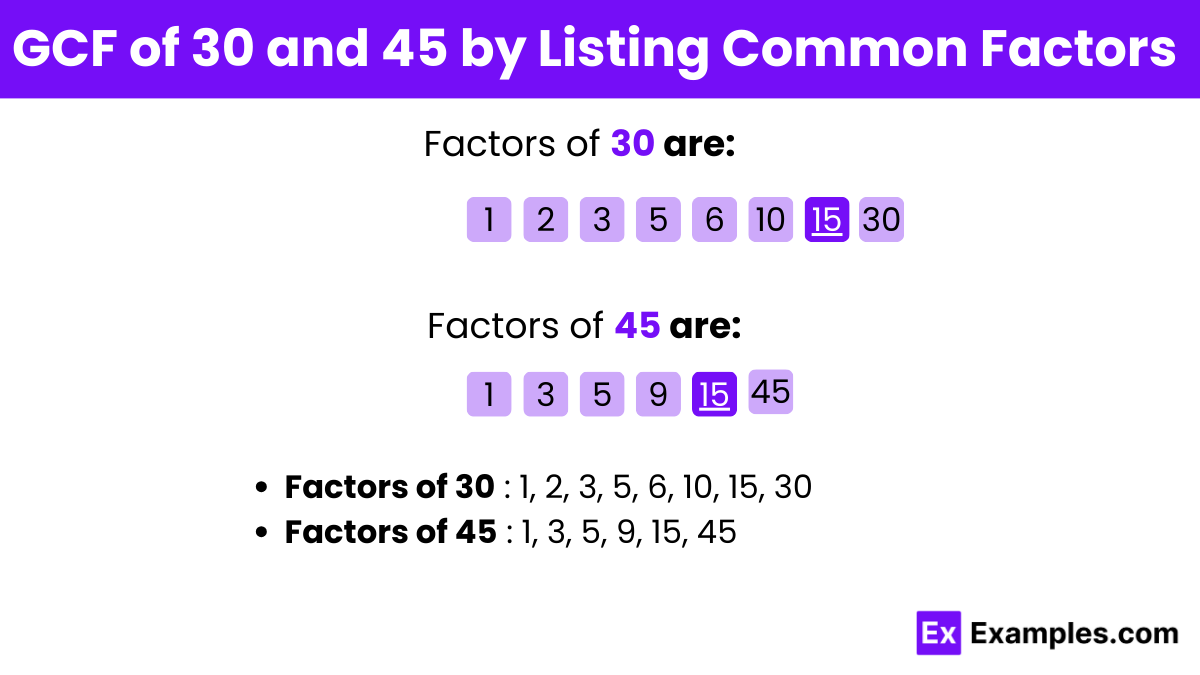The GCF of 30 and 45 is also the GCF of which of the following pairs?
12 and 15
45 and 75
24 and 30
60 and 90


To find the GCF (Greatest Common Factor) of 30 and 45, we start by listing the prime factors of each number. The prime factors of 30 are 2, 3, and 5 (since 30 = 2 × 3 × 5). For 45, the prime factors are 3 and 5 (since 45 = 3 × 3 × 5). Next, we identify the common prime factors between the two numbers, which are 3 and 5. Multiplying these common factors together gives us the GCF. Therefore, the GCF of 30 and 45 is 3 × 5 = 15.

To find the GCF (Greatest Common Factor) of 30 and 45 using the prime factorization method, follow these steps:
To find the GCF (Greatest Common Factor) of 30 and 45 using the prime factorization method, follow these steps:
Prime Factorization:
30: The prime factors of 30 are 2, 3, and 5.
30 = 2 × 3 × 5
45: The prime factors of 45 are 3 and 5.
45 = 3 × 3 × 5
Identify Common Factors:
Both numbers have the common prime factors of 3 and 5.
Calculate the GCF:
Multiply the common prime factors together.
GCF = 3 × 5 = 15
Thus, the GCF of 30 and 45 using the prime factorization method is 15.

Divide the larger number by the smaller number:
Divide 45 by 30.
45 ÷ 30 = 1 remainder 15
Replace the larger number with the smaller number and the smaller number with the remainder:
Now, divide 30 by the remainder 15.
30 ÷ 15 = 2 remainder 0
Continue the process until the remainder is 0:
Since the remainder is now 0, the divisor at this step is the GCF.
Therefore, the GCF of 30 and 45 using the long division method is 15.

List the factors of each number:
Factors of 30: 1, 2, 3, 5, 6, 10, 15, 30
Factors of 45: 1, 3, 5, 9, 15, 45
Identify the common factors:
Common factors of 30 and 45: 1, 3, 5, 15
Determine the greatest common factor:
The largest common factor is 15.
Therefore, the GCF of 30 and 45 by listing common factors is 15.
The greatest common factor (GCF) of 30 and 45 is 15. This is the largest number that divides both 30 and 45 without leaving a remainder.
No, the GCF is always less than or equal to the smaller number.
The common factors are 1, 3, 5, and 15.
The GCF is used to simplify fractions by dividing the numerator and the denominator by the GCF.
No, they are not relatively prime because their GCF is 15, not 1.

To find the GCF (Greatest Common Factor) of 30 and 45, we start by listing the prime factors of each number. The prime factors of 30 are 2, 3, and 5 (since 30 = 2 × 3 × 5). For 45, the prime factors are 3 and 5 (since 45 = 3 × 3 × 5). Next, we identify the common prime factors between the two numbers, which are 3 and 5. Multiplying these common factors together gives us the GCF. Therefore, the GCF of 30 and 45 is 3 × 5 = 15.
Prime Factorization Method
Long Division Method
Listing Common Factors
To find the GCF (Greatest Common Factor) of 30 and 45 using the prime factorization method, follow these steps:
To find the GCF (Greatest Common Factor) of 30 and 45 using the prime factorization method, follow these steps:
Prime Factorization:
30: The prime factors of 30 are 2, 3, and 5.
30 = 2 × 3 × 5
45: The prime factors of 45 are 3 and 5.
45 = 3 × 3 × 5
Identify Common Factors:
Both numbers have the common prime factors of 3 and 5.
Calculate the GCF:
Multiply the common prime factors together.
GCF = 3 × 5 = 15
Thus, the GCF of 30 and 45 using the prime factorization method is 15.
Divide the larger number by the smaller number:
Divide 45 by 30.
45 ÷ 30 = 1 remainder 15
Replace the larger number with the smaller number and the smaller number with the remainder:
Now, divide 30 by the remainder 15.
30 ÷ 15 = 2 remainder 0
Continue the process until the remainder is 0:
Since the remainder is now 0, the divisor at this step is the GCF.
Therefore, the GCF of 30 and 45 using the long division method is 15.
List the factors of each number:
Factors of 30: 1, 2, 3, 5, 6, 10, 15, 30
Factors of 45: 1, 3, 5, 9, 15, 45
Identify the common factors:
Common factors of 30 and 45: 1, 3, 5, 15
Determine the greatest common factor:
The largest common factor is 15.
Therefore, the GCF of 30 and 45 by listing common factors is 15.
The greatest common factor (GCF) of 30 and 45 is 15. This is the largest number that divides both 30 and 45 without leaving a remainder.
No, the GCF is always less than or equal to the smaller number.
The common factors are 1, 3, 5, and 15.
The GCF is used to simplify fractions by dividing the numerator and the denominator by the GCF.
No, they are not relatively prime because their GCF is 15, not 1.
Text prompt
Add Tone
10 Examples of Public speaking
20 Examples of Gas lighting
The GCF of 30 and 45 is also the GCF of which of the following pairs?
12 and 15
45 and 75
24 and 30
60 and 90
What is the difference between the LCM and GCF of 30 and 45?
90
105
120
135
Which of the following statements is true about the GCF of 30 and 45?
It is a multiple of 10.
It is a prime number.
It is an odd number.
It is a factor of 30.
The GCF of 30 and 45 is one-third of which of the following numbers?
15
30
45
60
The product of the GCF of 30 and 45 and the GCF of 60 and 90 is:
90
180
270
360
The sum of the GCF of 30 and 45 and the smallest prime number is:
16
17
18
19
If the GCF of 30 and 45 is divided by 3, what is the result?
3
4
5
6
What is the GCF of 3 times 30 and 3 times 45?
15
30
45
60
Which of the following is the correct prime factorization of the GCF of 30 and 45?
3 × 5
2 × 5
3 × 3
5 × 5
What is the GCF of 30 and 45, if 30 is divided by its smallest prime factor?
1
3
5
15
Before you leave, take our quick quiz to enhance your learning!

